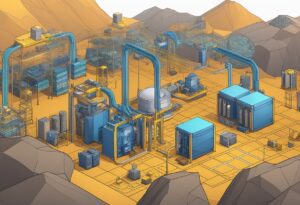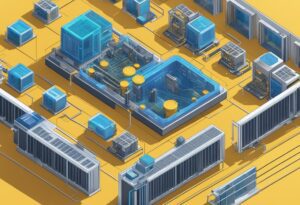Metaverse coin mining has become a popular way of earning cryptocurrency in recent years. Metaverse is a blockchain-based platform that allows users to create and trade digital assets and identities. Mining Metaverse coins involves using your computer’s processing power to solve complex mathematical problems and earn rewards in the form of ETP tokens.
Metaverse uses the Ethash mining algorithm, which is similar to the one used by Ethereum. To start mining Metaverse coins, you need to have a computer with a powerful graphics card and the latest drivers installed. It’s also important to join a mining pool, which is a group of miners who combine their computing power to increase their chances of earning rewards.
Metaverse coin mining can be a profitable way to earn cryptocurrency, but it requires a significant investment in hardware and time. As with any form of cryptocurrency mining, it’s important to stay up to date with the latest developments and trends in the market to maximize your profits.
What is Metaverse (ETP)?
Metaverse (ETP) is a decentralized platform that uses blockchain technology to create a virtual world where users can interact with each other in real-time. It is built on the concept of Blockchain-as-a-Service (BaaS), meaning users can make digital assets and have digital identities. The platform allows anyone to create decentralized applications or smart contracts on the platform’s ecosystem. Metaverse wants to include digital asset creation, and it has unique features compared to Ethereum.
Basics of Mining in the Metaverse
Mining Metaverse is important as it is a proof-of-work blockchain, which requires miners to solve complex mathematical equations to validate transactions on the network.
In return for their efforts, they are rewarded with newly minted coins. It is not very easy to determine the exact profitability of mining ETP because it depends on many variable factors. However, it is still a popular way to obtain ETP coins.
Mining Metaverse requires specialized hardware and software to solve the complex mathematical equations. The mining process involves validating transactions and adding them to the blockchain. The miner who solves the equation first is rewarded with newly minted coins.
The Role of Blockchain in Metaverse Coins
Blockchain plays a significant role in Metaverse coins. It is a decentralized platform that uses blockchain technology to create a virtual world where users can interact with each other in real-time.
The blockchain technology allows for secure, transparent, and immutable transactions. It ensures that the transactions are validated and recorded on the blockchain, making it difficult to tamper with the data.
Metaverse coin mining is an important aspect of the Metaverse platform. It allows users to validate transactions, add them to the blockchain, and earn newly minted coins. The blockchain technology ensures that the transactions are secure, transparent, and immutable.

Mining Hardware and Software for metaverse coin mining
CPU vs GPU vs ASIC Mining
When it comes to mining Metaverse coin, there are three primary types of mining hardware: CPU, GPU, and ASIC. CPU mining is the least efficient, and ASIC mining is the most efficient. However, ASIC miners are expensive and not very flexible. GPU mining is a good balance between efficiency and flexibility, and it is the most popular choice for mining Metaverse coin.
Choosing the Right Mining Software
Choosing the right mining software is crucial for successful mining. Some popular mining software options for Metaverse coin include CGMiner, BFGMiner, and EasyMiner.
These programs are compatible with both Nvidia and AMD graphics cards, and they allow for easy control of fan speed and other settings. It is important to keep mining software up-to-date with the latest drivers to ensure optimal performance.
Optimizing Mining Hardware Performance
To optimize mining hardware performance, it is important to keep the hardware cool and to adjust fan speed as needed. Overheating can cause damage to the hardware and slow down mining performance.
Overclocking can improve mining efficiency, but it should be done carefully and with caution to avoid damaging the hardware. Finally, it is important to choose mining hardware with a high hash rate to maximize mining efficiency.
Mining Pools and Profitability
How Mining Pools Work
Mining pools are groups of miners that combine their computing power to increase their chances of finding a block and earning a reward. When a block is found, the reward is distributed among the miners in proportion to their contribution to the pool’s hash rate. Mining pools charge a fee, which is usually a percentage of the reward, to cover their operating costs.
Selecting a Mining Pool
Selecting the right mining pool is crucial for maximizing profitability. Some factors to consider when choosing a pool include the pool’s fee structure, payout frequency, and reliability. It is also important to consider the pool’s hash rate and the total network hash rate.
A pool with a high hash rate will find blocks more frequently, but the rewards will be split among more miners. Conversely, a pool with a low hash rate will find blocks less frequently but will have fewer miners to share the rewards.
Calculating Mining Profitability
Mining profitability can be calculated using an online mining calculator, such as the one available on etp.sandpool.org. The calculator takes into account factors such as the mining reward, block reward, difficulty, and hash rate to estimate the miner’s expected earnings. It is important to note that mining profitability is affected by several factors, including the miner’s hardware, electricity costs, and the current market price of ETP.
Mining pools are an essential part of ETP mining, and selecting the right pool is crucial for maximizing profitability. By considering factors such as the pool’s fee structure, payout frequency, and reliability, as well as the miner’s hardware and electricity costs, miners can make informed decisions about which pool to join.
Using an online mining calculator can also help miners estimate their expected earnings and make adjustments to their mining setup as necessary.

Security and Maintenance
Protecting Your Digital Assets
When it comes to mining Metaverse, it is important to ensure that your digital assets are protected. One of the key ways to do this is by setting up a secure wallet address where you can store your ETP coins. It is recommended to use a hardware wallet, such as Ledger Nano S or Trezor, to keep your coins safe. These wallets offer enhanced security features, such as two-factor authentication and PIN protection, which make it difficult for hackers to access your funds.
It is important to regularly scan your mining software and batch files for viruses. Most mining software is flagged as a virus by antivirus software, but this is a false positive. However, it is still important to ensure that your software is not infected with any malware or viruses that could compromise your security.
Regular Maintenance and Troubleshooting
Mining Metaverse requires regular maintenance and troubleshooting to ensure that your mining rig is running smoothly. One of the key things to monitor is the temperature of your GPU. If the temperature gets too high, it can damage your hardware and reduce its lifespan. It is recommended to keep the temperature below 80°C to ensure that your hardware is running at optimal conditions.
In addition to monitoring the temperature, it is important to regularly update your drivers and software to ensure that you are using the latest versions. This can help to improve performance and fix any bugs or issues that may arise.
If you encounter any issues with your mining rig, it is important to troubleshoot the problem as soon as possible. This can involve checking your connections, updating your drivers, or adjusting your settings. By regularly maintaining and troubleshooting your mining rig, you can ensure that you are mining Metaverse efficiently and effectively.
The Future of Metaverse Mining
Trends in Metaverse Mining
The mining of Metaverse coins has been on an upward trend in recent years. With the increasing popularity of virtual reality and blockchain technology, the demand for Metaverse coins is expected to grow significantly. Mining Metaverse coins provides an opportunity for investors to earn rewards by contributing to the network’s security through the process of verifying transactions.
One of the trends in Metaverse mining is the use of blockchain-as-a-service (BaaS) platforms. These platforms provide a suite of tools and services for developers to build and deploy blockchain applications without the need for extensive knowledge of blockchain technology.
This makes it easier for developers to create decentralized applications on the Metaverse network, which in turn increases the demand for Metaverse coins.
Another trend is the use of the Substrate modular framework, which allows developers to customize and build their own blockchain networks.
This framework provides a flexible and efficient way of building blockchain networks, making it easier for developers to create and deploy decentralized applications on the Metaverse network.
Impact of Scalability and Stakeholders
Scalability is a critical factor in the future of Metaverse mining. As the network grows in popularity, the number of transactions on the network will increase, which could lead to scalability issues. To address this, the Metaverse team is working on improving the network’s scalability by implementing solutions such as sharding and off-chain transactions.
Stakeholders also play a crucial role in the future of Metaverse mining. As the network grows, the number of stakeholders will increase, and their influence on the network will become more significant. This means that the decisions made by stakeholders will have a significant impact on the future of Metaverse mining.
Therefore, it is essential to have a robust governance structure in place to ensure that the network is managed effectively and efficiently.
The future of Metaverse mining looks promising, with increasing demand for Metaverse coins and the development of new tools and technologies to support the network’s growth. However, it is crucial to address scalability issues and have a robust governance structure in place to ensure the network’s long-term success.
Frequently Asked Questions
What is metaverse mining?
Metaverse mining is the process of using computer hardware to solve complex mathematical problems in order to validate transactions on the Metaverse blockchain network. This process is necessary for maintaining the integrity of the network and for creating new Metaverse coins.
What is a metaverse miner?
A metaverse miner is a person or entity that uses specialized computer hardware to mine Metaverse coins. These miners are responsible for validating transactions on the Metaverse network and for creating new coins.
How much is metaverse miner token?
The price of the Metaverse Miner token varies depending on market conditions and demand. As of the current date, there is no fixed price for the token.
How do you get metaverse coins?
Metaverse coins can be obtained through mining, buying on cryptocurrency exchanges, or participating in the Metaverse ecosystem.
What are the steps involved in mining coins within the metaverse?
The first step in mining Metaverse coins is to set up a mining rig with specialized hardware and software. Once the rig is set up, the miner must join a mining pool or start solo mining. The miner then solves complex mathematical problems to validate transactions on the Metaverse network and create new coins.
How can one determine the legitimacy of a metaverse mining operation?
To determine the legitimacy of a Metaverse mining operation, one should research the company or individual offering the service, read reviews from other users, and check the company’s credentials and track record. It is important to be cautious of scams and fraudulent operations.
What factors influence the price of metaverse-specific cryptocurrencies?
The price of Metaverse-specific cryptocurrencies is influenced by a variety of factors, including market demand, supply and demand, technological advancements, regulatory changes, and investor sentiment.
Can metaverse coins be mined in a similar way to traditional cryptocurrencies like Bitcoin?
Metaverse coins can be mined in a similar way to traditional cryptocurrencies like Bitcoin, but with some differences. Metaverse uses the Ethash mining algorithm, which is different from Bitcoin’s SHA-256 algorithm. The Metaverse has a different block time and reward structure than Bitcoin.
What are the potential earnings from mining metaverse coins?
The potential earnings from mining Metaverse coins depend on a variety of factors, including the miner’s hardware setup, the difficulty of the mathematical problems being solved, and the current price of Metaverse coins.
How does the value of metaverse coins compare to standard cryptocurrencies?
The value of Metaverse coins is influenced by many of the same factors that influence the value of other cryptocurrencies. However, Metaverse has unique features and use cases that may differentiate it from other cryptocurrencies.




